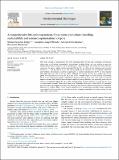| dc.description.abstract | This study presents a comprehensive life cycle assessment (LCA) of sisal yarn production, covering key phases such as cultivation, transportation, decortication, brushing, baling, and yarn making to assess the environmental impacts associated with the production of 1 kg of sisal yarn. The results show that cultivation contributes the most to global warming potential (7.29 kg CO eq, 51% of total emissions) and terrestrial ecotoxicity (112.02 kg 14-DCB eq, 97.7%), driven largely by the excessive use of pesticides, herbicides, and fertilizers. Decortication contributes significantly to marine eutrophication (83.7% of total impacts) and global warming (5.52 kg CO eq, 40%). Although yarn making accounts for a smaller share of the global warming potential (0.97 kg CO eq, 6.8%), it has a notable impact on human toxicity (contributing 21.7% to non-carcinogenic toxicity) and fossil fuel depletion (305.8 g oil eq, 10% of the total). A sensitivity analysis indicates that reducing chemical inputs, improving energy efficiency, and optimizing water use can reduce environmental impacts by up to 30%, lowering global warming potential to 11.59 kg CO eq in the improvement scenario. These results align with Sustainable Development Goals (SDGs) on responsible production (SDG 12), climate action (SDG 13), and life on land (SDG 15), positioning sisal yarn as a sustainable alternative to synthetic fibers. Future research should focus on incorporating renewable energy, expanding region-specific LCA inventories, and exploring social and economic sustainability to further enhance the sisal value chain’s sustainability. | en_US |

